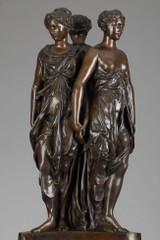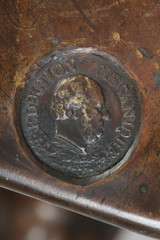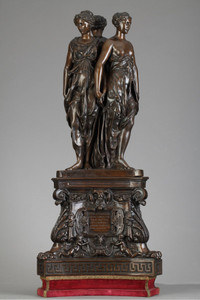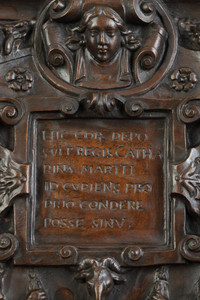






IMPORTANT BRONZE GROUP "LES TROIS GRACES" AFTER GERMAIN PILON, 19TH CENTURY
Large bronze group with nuanced brown patina, depicting three women leaning against each other, dressed in light tunics, their hands joined, as if sketching a very slow round. The measured elegance of the gestures, the serenity of the expression and the regularity of the faces are reminiscent of Antiquity. The bronze rests on a tripod base with rich Renaissance-inspired decoration, and a red velvet pedestal. It was made at the end of the 19th century after the monument to the heart of King Henri II, executed by Germain Pilon in the 16th century. Mechanical reduction stamp A. COLLAS. Bronze probably made by Barbedienne. Slight crack to one neck. Dimensions of bronze without base: W:45cm, D:40cm, H:96cm. Dimensions with base: W:45cm, D:40cm, H:103cm. The monument to the heart of Henri II was commissioned in 1561 by Catherine de Médicis for her late husband. Placed in the church of the Célestins convent in Paris, it was to receive the hearts of the king and queen of France. Germain Pilon sculpted the group of Graces, and the Italian Dominique Florentin created the triangular base. The group of Graces is inspired by an ancient group of the triple Hecate. It also evokes a cassolette designed by Raphaël for François I, and engraved by Marc-Antoine Raimondi. For the ancient Romans, the Graces symbolized marital fidelity. The inscriptions on the base, which commemorate the unbreakable union of the two spouses, lend credence to this interpretation. The monument thus legitimizes Catherine de Médicis's political role in ruling the kingdom. The marble original is now in the Musée du Louvre. Germain Pilon (Paris, circa 1528-1590) was one of the most important sculptors of the French Renaissance. He sculpted the tombs of 16th-century French kings. Son of the sculptor André Pilon, he studied terracotta modeling and stone carving with Pilon. Appointed Controller of the King's Hallmarks and Coins, he also learned the art of bronze casting and chasing. From 1558 to his death, he worked for the French court, creating the funeral monuments of François I and Henri II, the recumbent statues of the latter and Catherine de Médicis, and royal coins. He was also a popular sculptor with the French aristocracy, again specializing in funerary art. Bibliography: Base des oeuvres du Musée du Louvre. http://www.louvre.fr/oeuvre-notices/monument-du-coeur-d-henri-ii Late 19th century, Circa: 1880 Dim: W:45cm, D:40cm, H:102cm.










